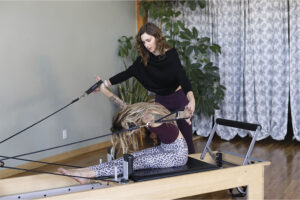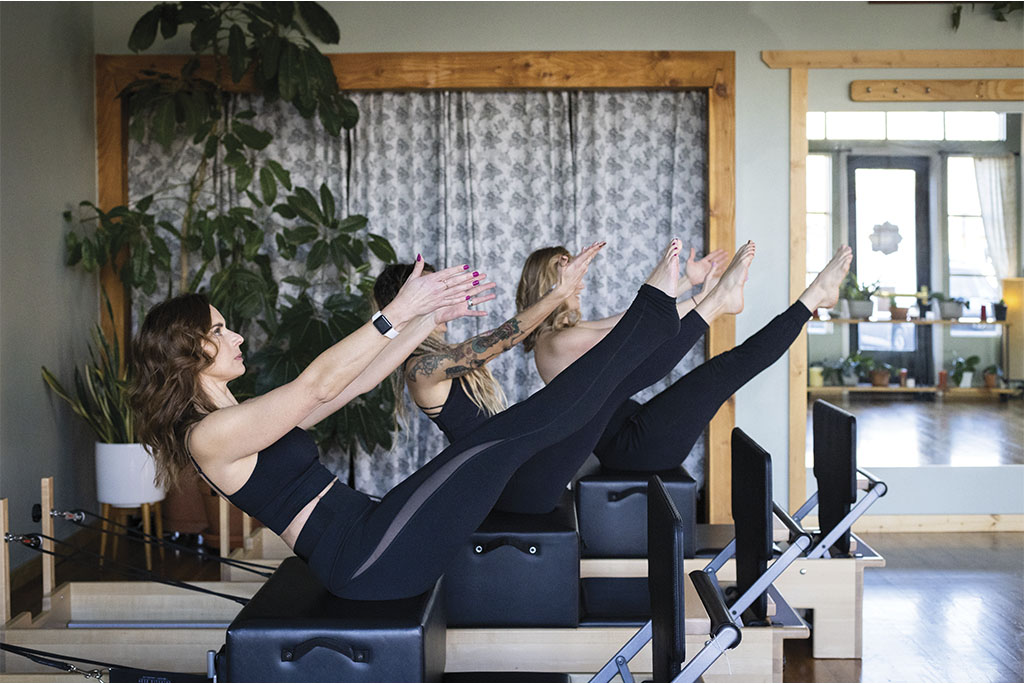In Idaho, our spectacular outdoors sets the stage for seemingly effortless fitness with its call to ski, hike, jog or cycle – tackle the terrain, and you’re rewarded with a beautiful view and a good workout. But age and injury eventually creep in, and whether it’s pride or pain, we tend to step back from the activities that used to be second nature. But what if there were an exercise regimen that kept you doing the things you love longer?
“That’s what Pilates is!” exclaims Gabrielle Rivelo, co-owner of CoreFocus, a Pilates, yoga and functional fitness studio in Hailey. “The workouts are compact and efficient. You balance your core, and everything else stems from there.”
Rivelo enthusiastically explains how Pilates calls upon muscles, fascia, tendons, ligaments and more. She teaches classes and private sessions, essentially picking up where physical therapy might leave off.
“Many times, people recovering from a large muscle injury learn they must rebuild all the supporting structures around the muscle. Pilates helps with that. And done proactively, it goes deep to build balance and strength to prevent injury and improve overall performance.”
Pilates is generally done in small groups or one-on-one sessions. Optimally, an instructor helps you stay properly aligned and anatomy-focused. Without that guidance, Rivelo says, you might not get the best effect. The whole body doesn’t engage until the core is aligned and supported.
A typical Pilates studio might look like a medieval torture chamber to some. A variety of apparatus with springs, slides and pulleys. The devices have names like The Reformer, Wunda Chair and the Ladder Barrel. The father of the discipline, Joseph Pilates, invented the equipment and excercises to speed the process of stretching, strengthening, and aligning the core.
Rivelo’s evangelism of the practice spurs from the many turnaround stories she’s personally witnessed, recounting the case of a client with limited movement due to a spinal injury and subsequent surgery. “In his 50s, he’d been told it was the end of his skiing, biking and running days. But three years of strengthening and lengthening the spine using the Pilates method allowed him to return to backcountry skiing, which he does now well into his 70s.” 
One of the biggest affirmations Rivelo receives is when a client discovers a ‘new’ muscle. “It’s proof that something definitely happened during their Pilates workout,” Rivelo says. “We reached a part that is not getting used any other time. That’s the unseen part of fitness that supports the work of the larger muscles.”
Intentionally accessing the micromotor structures allows easier everyday use of the bigger muscles we typically use without much thought, adds Rivelo. “You’re setting yourself up for cross conditioning, which is huge for our hyper-athletic population here in the valley. Our bodies need movement and variety to be happy and healthy.”
Though Pilates seems to be having a ‘moment,’ it’s been practiced in the Wood River Valley for over thirty years—its popularity waning during the hot yoga trend. Now more studios and gyms have added it to their fitness lineups. Despite the greater availability, Lisa Hamilton says she’s busier than ever at her eponymous studio in Hailey. One reason may be that Pilates workouts can be scaled to almost any fitness level and body type. That makes it an option for people of all ages and abilities. Hamilton’s been teaching Pilates since 2002. Her typical client is between 40 and 85. “People do Pilates to stabilize their core. That keeps them in their favorite activities longer, whether it’s pickleball, golf or skiing. Pilates is really the exercise you do so you can stay active in life.”
Zenergy Health Club and Spa remodeled its Pilates studio last October. General manager Derek Agnew says with the input of his highly knowledgeable team of instructors, the club converted from classic equipment to new Balance Body Reformers with towers. “It’s made a huge difference in participation. Even with more than 20 reformer group clinics per week, we consistently fill 90 percent of our slots,” he says.
Agnew reports overall participation is up over 200% since the remodel, giving full credit to the Club’sgreat instructors and the new studio set-up. “The Balance Body units deliver a more dynamic workout in a one-hour session. I’ve been blown away by our members’ response,” Agnew says.
Private Pilates lessons at the club are open to the public and come with the added benefit of an all-day pass to enjoy other club amenities like the pool, sauna, cold plunge or jacuzzi.
Barre fitness classes combine elements of dance, yoga and Pilates for full-body strengthening. Classes are typically conducted in a studio equipped with bars and have grown to include resistance bands, weights and exercise balls. Instructors focus on small, pulsing movements, targeting areas to fatigue, leading
to strengthening.
Barre classes have consistently been one of the most popular group fitness activities at Ketchum’s Zenergy Health Club and Spa. Group fitness manager Kati Freytag is a Barre devotee herself, despite her original entry into the fitness world as a Pilates instructor. “Barre, Pilates and yoga share some similarities. They’re each great for all-over body toning. They build strength, and that helps lower the risk of injury. That’s very important to our active community,” Freytag says.
Zenergy offers six Barre classes per week. Freytag says students’ ages range from the 20s through the 70s. “There’s no heavy lifting, and movements can be modified for every fitness level whether someone is rehabbing from injury or conditioning for an upcoming sport season.”
The ballet style movements, says Freytag, fine-tune and tone the smaller muscles that connect to the tendons and joints for a deeper workout. Sure, your quads will get a good workout, but step up to the wall-mounted barre, where the demands on minor muscles
are made during standing balance work. Freytag says instructors are meticulous
about proper form to target those essential stabilizing muscles.
WHAT IS PILATES
Pilates is similar to yoga combining physical movement with purposeful concentration and breathing. But Pilates focuses more on core strength. It can improve flexibility, strength, balance and circulation and is typically practiced in a studio using various equipment designed to maximize and accelerate results.
Pilates Progression
• Overcoming a fragile childhood, German-born Joseph Pilates develops an exercise regimen in the early 20th century to improve his health.
• In the 1920s, Joseph Pilates immigrates to the U.S. and opens a New York City studio.
• In the 1950s, the practice becomes popular for injury prevention and rehabilitation.
• In the 1980s, Pilates gained popularity in the mainstream for overall fitness and well-being.
• In 2000, Newsweek reports 5,000 Pilates devotees in the U.S.
• 9.7 million Americans are believed to practice Pilates as of 2021 (Statista.com)
• Pro athletes LeBron James, Tiger Woods and Cristiano Ronaldo have all said they
do Pilates.
The Barre Beginnings
• Created by London ballerina Lotte Berk in 1959, who used
ballet barre routines to restore her injured back.
• In 1971, a former student opens the first Lotte Berk Method
studio in the U.S.
• The studio closes in 2005.
• Barre method experiences rapid expansion in the 2010s, mostly credited to former Lotte Berk instructors founding major exercise chains.
• An estimated 4 million Americans attend Barre fitness classes today.
• Jennifer Lopez, Kyra Sedgewick and Kelly Ripa are among many celebrities who exercise at barre studios.


